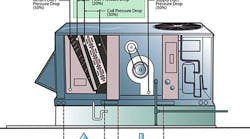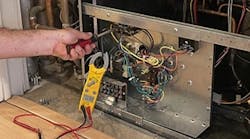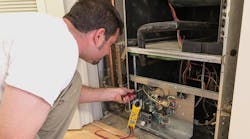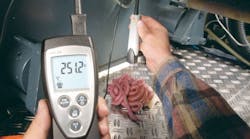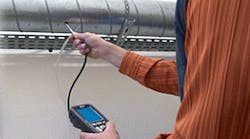The accepted ideal for most buildings, whether a residential or light commercial structure, is to place them under a positive pressure of +.02-in. to +.03-in. water column. These are very slight pressures that can make a huge difference in building comfort and efficiency.
We create positive pressures in a building by installing a fresh air duct to the HVAC system or by properly installing a Heat Recovery Ventilator (HRV). Positive pressure controls ventilation into a building, and keeps air from being pulled in from undesirable locations.
Fresh air pressurizes a building as it's introduced into the return side of the system before the fan. The amount of return air is reduced by the amount of the fresh air. So if 10% fresh air is brought into the system, the fan can only pull 90% of the return air through the return ducting. The supply side still delivers 100% of its airflow. So, supply airflow exceeds return airflow in the building, leaving a positively pressurized building.
The amount of air required to pressurize a building will increase depending on how leaky the building envelope is. For adequate positive building pressure, some building pressurize with as little as 50 cfm of outside air per every 1000 square feet. Some buildings need as much as 300 CFM or more per 1,000 sq.ft.
Exhaust fans create a negative pressure in a building. Those rooms, such as rest rooms, containing cleaning or other chemicals should be placed under a negative pressure with an exhaust fan to prevent fumes and smells from migrating around the building.
Mechanical Rooms
Positive pressure is critical in mechanical rooms where combustion appliances are located to prevent flue gasses from being pulled into the building. In mechanical rooms, always verify a positive or at least a neutral pressure. A negative pressure in a mechanical room or combustion area as low as .015 in. can cause a gas furnace, water heater, or other gas appliance to back draft and carry deadly carbon nonoxide into the building. This poses a serious health exposure to the occupants.
Consider installing a small supply register on the supply plenum with a manual damper that can be adjusted to assure the combustion area is kept under a positive pressure when the system fan is energized. An outside air fan may be necessary in mechanical rooms with boilers.
Other pressures act upon a building, as well. Wind is one and it changes from moment to moment. Wind exerts a positive pressure on the windward side and a negative pressure on the downwind side. Stack effect, the upward flow of warmer air, also creates slight pressures. Doors opening and closing do too. Don't forget clothes dryers and kitchen exhaust fans. The bottom line: There are conditions where you cannot effectively measure building pressures. Also, whenever you test, be mindful that there may be other pressure events in a building that may be outside of your experience and consideration.
Instruments and Tools
To measure building pressures, you'll need a digital manometer with typical test range from 0-in. to 5-in. w.c. with a readable scale of at least .005-in. w.c. Manometers with larger scales are unable to read lower pressure with the required accuracy. Analog gauges should be a 0 to 1/4-in. w.c. scale to read building pressures accurately.
You'll need tubing or pressure hoses to connect to the manometer through which the pressure travels to the pressure ports. Building pressure testing may require up to 100 ft. of tubing. The best pressure tubing measures 5/16 OD by 3/16 ID, but any tubing that will make a tight seal on the port of the manometer will do.
How to Measure
Set the fans and building conditions in the mode that reflects the state you wish to measure. Normally, bring on the fan for the HVAC system, with other fans off to start with. To measure the building pressure with reference to outdoors, select an outdoor location and place the open end of the pressure tubing outdoors, away from the wind.
Run the tubing indoors through a door or window. Be sure not to pinch off the tubing. You may need to use masking tape to block off the open area of the door or window to be sure the pressure areas remain separate.
At the indoor location, connect the pressure tubing to the negative port on the manometer. The difference between the two pressures will appear on your manometer. If a negative pressure appears positive on the meter, simply switch the hoses on the ports. You may verify a positive or negative pressure in the building visually by using artificial smoke testing at the door or window.
Pressure can be measured between rooms or pressure zones in the same manner. Simply place the open end of the hose in one zone, and then stand in the other pressure zone with the manometer. The port with the tube connected measures one pressure, the open port on the manometer measures the other pressure. The difference between the two pressures appears on the face of the manometer.
Overcome the Wind
When measuring building pressures with reference to outdoor pressure, the wind can cause enough fluctuations in your readings that testing becomes futile. To stabilize the outdoor pressure, place the outdoor end of your pressure tubing into a sheltered area unaffected by the wind. Many contractors I know place the outdoor end of their tubing in a Tupperware bowl with holes punched in the top, then fill it loosely with paper towels to diminish the effects of the wind on outdoor pressures.
Smoke Makes Pressures Visible
High pressure travels to low pressure and smoke makes the movement apparent. Titanium Tetrachloride is a chemical that reacts with the moisture in the air to produce a cool smoke. So, a puff of smoke makes the traveling air visible. This can be a real help before, during, or after pressure measurement.
One method to check if a room has a positive or negative pressure with reference to the neighboring room is to open the door an inch or so, then blow smoke gently near the opening. In theory, if the room has a positive pressure, the smoke will blow out of the room. If the room has a negative pressure, the smoke will be pulled back into the room.
Good pressure diagnosticians understand that they don't make a decision on how the building is operating based on a single test or on a 1/100th of an inch pressure differential. Pressures change throughout a building from minute to minute. So advanced pressure testing may require building pressure traverses, a sense of patience and some creativity.
Rob Falkeis president of National Comfort Institute. He can be reached at 800/633-7058, e-mail Rob at [email protected]. If you're an HVAC contractor or technician interested in a Building Pressure Measurement Procedure and Report, drop Doc a line at the e-mail above.